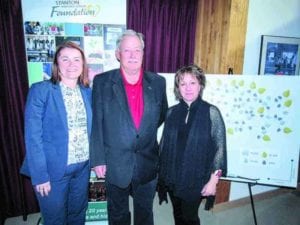The Stanton Territorial Hospital Foundation is proving to be one of the bigger winners following a lawsuit settlement that saw cellphone provider Bell Mobility pay out more than $1 million after charging customers a fee for a non-existent 911 emergency phone service.

On March 31, Bell Mobility Inc. wrote a $123,044.70 cheque to the hospital foundation, a charitable organization that has previously raised money for needed equipment at the hospital, such as new dialysis units and a mammography machine.
The money was left over from the settlement Bell was ordered to pay last June after a decade-long court battle over the 75 cent fees with Yellowknife plaintiffs James Anderson and his son Samuel Anderson, who launched a class-action lawsuit on behalf of Bell customers in November 2007.
“At the end of the day what's left over went to the charity. Bell shouldn't have done this, and so one way or the other they paid money out,” said the Andersons' lawyer Sam Marr.
From Oct. 28, 2004 until Nov. 20, 2009, Bell Mobility charged either separate or bundled 911 fees of 75 cents per month in the Yukon, Northwest Territories and Nunavut, despite the fact that no 911 emergency service was available anywhere in the North except for Whitehorse. Instead, calls would be routed to a recorded message.
A class action lawsuit commenced in 2007 and Bell was found liable in 2013. The settlement was approved last June, with Bell ordered to pay back funds to around 25,000 customers in the North who signed a contract with the company prior to April 13, 2010.
Marr said under the terms of the settlement, people who are still Bell customers would have their portion of the settlement credited back to their accounts. People who were no longer customers would have cheques mailed to their last known address -- and if they hadn't been cashed within six months, that money would be donated to charity. The Andersons legal team chose the Stanton foundation as the recipient for any unpaid funds.
“The settlement agreement itself specifically said that they can't keep this money, it has to get paid out,” said Marr.
“Part of the thinking behind all this was that because this is 911 service, as I understand, this charity would help people in emergency situations as well, because of what they do.”
Of the $1,016,336.57 awarded, $515,737 went to legal fees and the Andersons received $5,000, according to Bell.
The company told Yellowknifer it issued credits to the account of 9,045 current customers, for a total of $207,360.70 -- about $23 per account.
Bell issued another $288, 276.25 in refund cheques to the last known addresses of 15,346 people who no longer subscribed. After $165,231.55 of that was cashed, the remaining, unclaimed amount went to Stanton.
Big birthday gift
Added together, the amounts adds up to a big birthday present for the Stanton Territorial Hospital Foundation, which celebrated its 20th anniversary last week.
“We just got a nice gift this week,” said Linda Bussey, executive director of the foundation.
She couldn't say specifically what the money would be spent on yet.
“We're waiting for the new hospital to be built, because we don't want to buy a piece of equipment that is not going to be in use,” she said. “The hospital has asked us to really take our time, and they have to tell us what they need ... But we're going to be ready when they say this is what we need, we'll have the money.”
Over its 20 years in existence, the foundation has raised around $7.5 million, and purchased numerous pieces of equipment, including a digital mammography machine, a CT scan, and dialysis machines, as well as funding a cancer care navigator, who helps guides and supports families when they're going through cancer treatments.
Bussey said the foundation is looking “outside the box” when it comes to their next big spending projects.
“We're trying to be creative-- we're really really looking at different initiatives, different programs because we don't just buy equipment. That's one thing people don't realize,” she said.
“So we're looking to do more of maybe having bursaries for staff, scholarships, and supporting families that might need any kind of support during chemo treatment or if there's traveling outside of the NWT.”
The foundation is also launching its next fundraising effort, a donor tree where people can buy one of three levels of leaves. Bussey hopes the effort will net the foundation around $50,000.
“Their names will be engraved on the leaves and they will be in the hospital for all time,” said Sandra MacKenzie, foundation chair, adding in the next few months the foundation will also be working on sponsorship for different rooms at the new hospital.
She said these efforts mean more people can stay in the territory, instead of having to travel for health care.
“All of that money has stayed in the North and has benefited people in the North, which is very unique for charities up here,” she said.